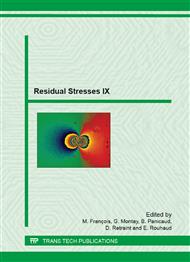p.603
p.609
p.615
p.622
p.628
p.634
p.640
p.646
p.652
Numerical Assessment of Residual Stress Induced by Machining of Aluminum Alloy
Abstract:
A numerical approach has been developed to predict the near surface residual stresses induced by turning in orthogonal cutting configuration of aluminum alloy AA7075-T651. This approach is based on a Lagrangian formulation using the finite element software Abaqus–Explicit. The calculated residual stress profiles were validated by experimental measurements using X-ray diffraction method on samples turned under different cutting conditions. Using this method, the effect of the cutting speed and the feed on the machining residual stress has been established.
Info:
Periodical:
Pages:
628-633
Citation:
Online since:
August 2014
Authors:
Permissions:
Share:
Citation:


